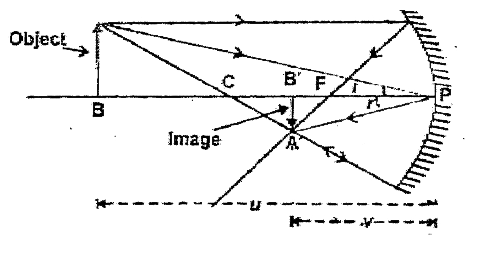Explain the sketches the formation of
a real enlarged image for a concave mirrorSolution in Punjabi
New Cartesian sign conventions :
(i) All the distances are measured from the pole of the mirror.
(ii) All the distances measured in the direction of incident ray are taken as positive and those opposite to the direction of incident ray are taken as negative.
(iii) All distances measured in vertically upward direction from the principal axis are taken as positive and in vertically downward direction as negative.
Mirror formula A relation between distance of object, distance of image from mirror and focal length of the mirror is known as mirror formula.
Derivation of mirror formula : Let an object AB is held perpendicular to principal axis of concave mirror beyond C and it forms the real and inverted image A.B between C and F as shown in Fig:

As triangles ABC and A.BC axe similar,
ABA.B.=CBCB ....(1)
Again triangles ABPand A.BP are similar,
ABA.B.=PBPB.....(2)
From eqns. (1) and (2), we have
CBCB=PBPB ..(3)
Measuring all distances from P, we have
CB=PB−PC
CB.=PC−PB.
∴ From eq. (3),
PB−PCPC−PB=PBPB
Using new Cartesian sign conventions, we have PB = -U (Distance of object measured against incident light) PC= - R"(Radius of curvature measured against incident light) PB =-v (Distance of. image measured against incident light) We get from eqn. (4)
∴ We get from eqn. (4)
−u−(−R)−R−(−v)=−u−v or −u+R−R+v=−u−v
Cross multiplying
vu−vR=uR−uv or uR+vR=2uv...(5)
Dividing both sides by uvR, we get
uRuvR+vRuvR=2uv4uvR
⇒1v+1u=2R
But we know that R = 2f
∴1u+1v=22f
⇒1u+1v=1f
which is the required mirror formula.
Topper's Solved these Questions
- BOOK - BETTER CHOICE PUBLICATIONCHAPTER - REFLECTION OF LIGHT EXERCISE - MOST EXPECTED QUESTIONS (1 Mark)3videos
REFLECTION OF LIGHT
- BOOK - BETTER CHOICE PUBLICATIONCHAPTER - REFLECTION OF LIGHT EXERCISE - MOST EXPECTED QUESTIONS (2 Marks)4videos
REFLECTION OF LIGHT
- BOOK - BETTER CHOICE PUBLICATIONCHAPTER - REFLECTION OF LIGHT EXERCISE - SHORT ANSWER TYPE QUESTIONS (3 Marks)1videos
REFLECTION OF LIGHT
- BOOK - BETTER CHOICE PUBLICATIONCHAPTER - RADIOACTIVITY EXERCISE - MOST EXPECTED QUESTIONS6videos
RADIOACTIVITY
- BOOK - BETTER CHOICE PUBLICATIONCHAPTER - REFRACTION OF LIGHTEXERCISE - NUMERICAL PROBLEMS36videos
REFRACTION OF LIGHT
Similar Questions
What is the minimum size of the plane mirror , in which a man can see his full height?Explain.
07:20View SolutionDifferentiate between a real image and a virtual image.
06:17View SolutionWhen an object is placed beyond centre of curvature of a concave mirror, the image is formed:
04:18View SolutionWhat are γ-rays?
48:26View SolutionA convex lens of refractive index 1.5 has a focal length of 18 cm in air.Calculate the change in focal length,when it is immersed in water of refractive index 4/3.
48:26View SolutionExplain the formation of images by a concave mirror with the help of a ray diagram.
01:52View SolutionExplain the formation of real and virtual images. Discuss what kind of images are formed in plane, convex and concave mirrors.
02:00View SolutionA concave mirror produeces a three times magnified (enlarged) real image of an object placed at 10cm in front of it. Where is the image located?
01:49View SolutionImage Formation By Concave Mirror
View SolutionImage Formation By Concave Mirror
05:11View SolutionAn object placed between the pole and focus of a concave mirror produced a virtual and enlarged image. Explain this using mirror formula.
01:52View SolutionA concave mirror produces three times magnifed (enlarged) real image of an object placed at 10cm in front of it, where is the image located?
06:17View SolutionThe mirror used for getting real and enlarged image is…… .
View SolutionA concave mirror produces three times magnified (enlarged) real image of an object placed at 10cm in fron of it. Where is the image located?
01:24View SolutionDraw the ray diagram to show the formation of real and virtual image in concave mirror.
01:39View SolutionAn object placed between the pole and focus of a concave mirror produced a virtual and enlarged image. Explain this using mirror formula.
41:15View Solution

